Abstract
Sri Lanka has agreed with policy of the United Nations Framework Convention on Climate Change (UNFCCC) from its beginning stage and with the Kyoto Protocol since 2002. Accordingly, Nationally Determined Contributions (NDCs) were introduced as part of the Paris Agreement on Climate Change, which Sri Lanka signed in 2016. Sri Lanka’s NDCs comprise four sections including of five mitigation sectors as energy, industry, transport, waste and forestry and eight adaptation sectors as agriculture, fisheries and livestock, health, water and irrigation, coastal and marine bio-diversity, tourism and recreation, urban and city planning, and human settlement. In addition to these 13 sectors, Sri Lanka NDCs focus on Loss and Damage as well as Implementation process of NDCs. Under Sri Lanka’s NDCs, government has planned 110 sector-wise programs. Of these, 43 are for the mitigation sectors, 58 for the adaptation sectors, 5 for the loss and damage sector, and 4 for the implementation sector. However, the ground truth of above programs is that they are quite changeable due to the lack of awareness of the public. Hence, this research focuses on a case study that evaluates the mitigation and adaptation strategies of tea growers in Sri Lanka, as this will be useful to apply the enhancement of the NDCs program to the agriculture sector. The case study comprises 6 mitigation methods and one adaptation method. Final output of the case study has been compared with NDCs’ tasks related to agriculture sector as pilot survey.
Keywords: Climate changeclimate mitigationadaptation to the climateclimate actionsUNFCCCNDCs
Introduction
Sri Lanka has entered into a part of the agreement to the United Nations Framework Convention on Climate Change (UNFCCC) from 1993 including its Kyoto Protocol since 2002. Accordingly, Sri Lanka has initiated major activity from 1993 to the present-day to mitigation and adaptation and mitigation of climate change (Ministry of Environment of Sri Lanka, 2010). Accordingly, Sri Lanka has three major tools to implement the mitigation and adaptation process in Sri Lanka namely, National Communication on Climate Change (NCCC), Nationally Determined Contributions (NDCs) and National Adaptation Plan (NAP) Hewawasam & Matsui, 2019).
NDCs Process
The Nationally Determined Contributions (NDCs) of Sri Lanka is the current mechanism of climate change mitigation in Sri Lanka (Pauw et al., 2018); Haque et al., 2019). NDCs was introduced as part of the Paris agreement on Climate Change that Sri Lanka signed in 2016 (INDCs, 2017). Accordingly, as mention above, NDCs include four components comprising 5 mitigation sectors, which are energy, industry, transport, waste and forestry as well as 8 adaptation sectors, which are agriculture, fisheries & livestock, health, water & irrigation, coastal & marine bio-diversity, tourism & recreation, urban & city planning, and human settlement. In addition to these 13 sectors, under Sri Lanka’s NDCs, government has planned 110 sector-wise programs. Of these, 43 are for the mitigation sectors, 58 for the adaptation sectors, 5 for the loss and damage sector, and 4 for the implementation sector.
The National Adaptation Plan (NAP Process)
The National Adaptation Plan (NAP) for Climate Change Impacts in Sri Lanka (2010-2016) has been formulated in accordance with the procedures given by the UNFCCC. The Sri Lanka's NAP had initiative with general process of UNFCCC four stages which has been customized to suit the specific situation prevailing in a country. The NAP process in Sri Lanka beginning with the preliminary elements, and later focused true planning steps of the route; then Sri Lanka-specific NAP methodology was introduced and developed based on the procedures of the international norms.
The standing of modifications as techniques lead to strategy for facing the threat of climate change has been established action plan as Intended Nationally Determined Contributions (INDCs) by all countries which singed the Paris Agreement. The requirement for adaptive strategies have also been emphasized in the Sustainable Development Goals (SDGs) by the United Nations in 2015.
Second National Climate Change Adaptation Plan, Sri Lanka (2015) mentioned that this tropical country is vastly exposed to the effects of Climate Change. While NAP as national level action plan will play a key role, cooperation of international level is also vital when admitting this responsibility, the Sri Lanka has commenced a national initiative for facing the risk of Climate Change (SNC, 2010). Ministry of Mahaweli Development and Environment of Sri Lanka have taken the leadership role as a key ministry. The Ministry’s actions have been reinforced by the Climate Change Secretariat (CCS), which is also the National Designated Entity (NDE) for the United Nations Framework Convention for Climate Change (UNFCCC). The key target of this national initiative has been started as the National Climate Change Adaptation Strategy for Sri Lanka in 2010 and the National Climate Change Policy (NCCP) formulated in 2012. The NAP focuses on adaptation needs at two different stages, namely the adaptation needs of key vulnerable sectors and the cross-cutting national needs of adaptation. There are 9 sectors, which are water, coastal, health, human settlement, bio-diversity, tourism & recreation, industry, energy, transportation.
Climate Change Adaptation Action Plan of the Western Province of Sri Lanka (2014) was taken forward by the Western Provincial Ministry of Agriculture, which decided to form a Provincial Action Plan to Adapt to Climate Change. The aim of the Climate Change Adaptation Action Plan of the Western Province is to ensure that Climate Change Adaptation Strategies form an integral part of management planning and processes, as this is essential for the Western Province of Sri Lanka to prepare for the current and future impacts of Climate Change. In addition, the concerned planners have said that rapid urban growth has posed a number of problems in the Western Province of Sri Lanka (World Health Organization, 2015), which is the most urbanized province in the country. Large tracts of agricultural lands have been converted to residential and commercial land uses, significantly altering natural water courses and drainage. This, coupled with an increase in extreme rainfall events, has resulted in recurrent flooding and related damages to infrastructure, utility services and the urban economy (Asian Foundation 2012). This briefly illustrates how the Western Province is promoting urban and peri-urban agriculture and forestry as a strategy to reduce vulnerability to Climate Change, while at the same time enhancing urban liveability and livelihoods. The National Climate Change Policy of 2012 has incorporated statements encompassing both Climate Change Adaptation and Mitigation.
Problem Statement
The Nationally Determined Contributions (NDCs) of Sri Lanka serve as the current mechanism of climate change mitigation in Sri Lanka. NDCs were introduced as part of the Paris agreement on Climate Change, which Sri Lanka signed in 2016 (INDCs, 2017). Sri Lanka’s NDCs include 4 components which comprise 5 mitigation sectors as energy, industry, transport, waste and forestry and the eight adaptation sectors as agriculture, fisheries & livestock, health, water & irrigation, coastal & marine bio-diversity, tourism & recreation, urban & city planning, and human settlement. In addition to these 13 sectors, Sri Lanka NDCs focus on Loss and Damage as well as Implementation process of NDCs. However, the major challenge is how to implement the NDCs activities at the grassroots level and how to monitor the results achieved by NDCs from the bottom level up to national level. This study will provide an example of grassroots level mitigation and adaptation issues involving a tea plantation to illustrate the agriculture plan of NDCs of Sri Lanka.
Research Questions
What is Sri Lanka NDCs Plan in the Agriculture Sector?
How do Sri Lankan tea plantations address the mitigation and adaptation techniques?
What are the grassroots level climate change mitigation and adaptation methods, that can be
compared with the newly introduced NDCs Plan in Sri Lanka's Agriculture sector?
Purpose of the Study
As mentioned above National Determine Contributions programme of Sri Lanka include 4 sections comprising five mitigation sectors and 8 adaptation sectors. Additionally, to these 13 sectors, it has planned to make grass roots level 110 sub-sector-wise programs. Of these, 43 are for the mitigation sectors, 58 for the adaptation sectors, 5 for the loss and damage sector, and 4 for the implementation sector. Accordingly, a case study is examined to see how grassroots level work can be integrated into Sri Lanka's NDCs. This case study will then be compared with the NDCs’ Agriculture Sector Plan, which is to be implemented in Sri Lanka. Following are the sub-components of the NDCs’ Agriculture Sector Plan focusing of tea plantation sector in Sri Lanka.
1. Minimize the pest damage by promoting the Integrated Pest Management (IPM) practices including controlling of environmental impacts on health.
1.1 Initiate bio degradable pesticides IPM method lead to environmentally friendly.
1.2 Introduce, promote and develop suitable bio-pesticides and bio-control agents for IPM.
1.3 Initiate, develop and promote post-harvest management with environmentally friendly technology packages.
2. Introduce and develop crop varieties that are resistant/ tolerant to biotic and abiotic pressures rising from climate change.
2.1 Implementation of programmes on heat tolerant varieties of crops
2.2 Implementation of programmes on drought tolerant varieties
2.3 Implementation of programmes on flood tolerant varieties
2.4 Implementation of programmes on develop salt tolerant varieties
2.5 Implementation of programmes on mature varieties of crops
3. Agro Ecological Regions (AERs) of Sri Lanka's maps will be re-demarcated with evaluation of current climate and future climate records and recommendations will be made available for suitable crops in different areas which has to be reduced level of vulnerability from impacts of climate change.
4. Applications of land and water management for central highlands area, land and water productivity and where the marginal land degradation occurred will be improved
4.1. Soil Conservation Act will be amended to support land productivity.
Research Methods
The tea tree is actually a shrub. To reduce the effects of extreme weather on the plant the tea growers use the mitigation methods and adaptation methods. It is possible to increase the tea yield and tea quality by using these methods.
Mitigation Method
Shading Plants for Mitigating High Temperature
The tea industry has been affected by the extreme weather conditions that have been prevailing in the past and at present (Wijeratne et al., 2007). Answering the questionnaire, the 60 selected tea growers stated that the tea cultivation in the area has suffered much from the bad weather. This study found that these growers were following different strategies to minimize the effects of the extreme temperature (Silva & Abesinghe, 2011). The tea tree is a shade-loving plant, so it is important to use temperature reduction techniques to increase the yield during the growing months. For this purpose, tall shade providing trees are planted within the tea plantation among the tea shrubs. The tea growers know about a variety of trees suitable for this purpose to macth their land size as indicate the below table
Out of the total number of 60 tea lands that were selected for the study, 20 lands cultivated high shade trees. This plant species is known as
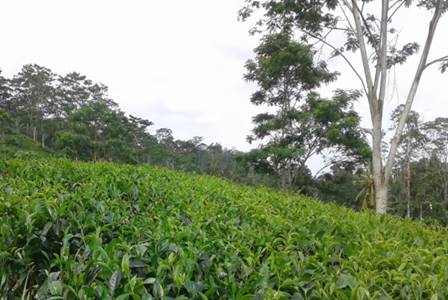
Medium-sized plants can also be grown to provide shade. A popular plant for this purpose can be
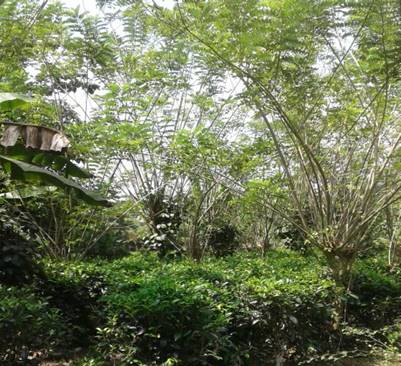
Frequently other income crops are cultivated, both to reduce the high temperature and to get additional income. Pepper and coconut could be seen as popular cultivated crops which is indicate the figure
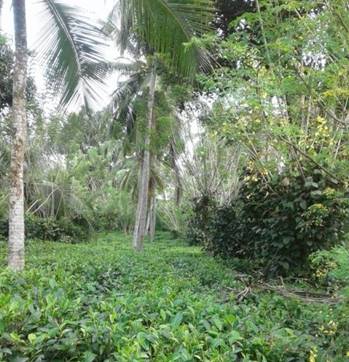
Mitigation Method for Affected Tea Lands in High Rainfall Areas
Different methods have been adopted to minimize soil erosion in these smallholdings. Some of the mitigation methods used against soil erosion, stone walls, drains and the planting of bushes as indicate in figure
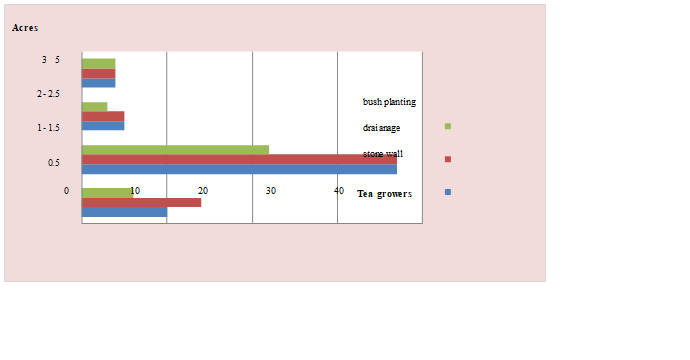
In addition to these methods, small plants were covered to protect them from the heat. It was also problematic to use fertilizer during high temperature periods. As a way of avoiding this problem tea cultivators switched over to liquid fertilizer for tea planting. When applied, liquid fertilizers are quickly absorbed into the tree. Soil moisture was protected by applying organic matter to tea land. Tea trees could thus be prevented from wilting and dying due to the high temperature.
Adaptation Method
Changes in the temperature and rainfall patterns have had a major impact on tea cultivation. The Hawpe Grama Niladhari Division located in the low country has been identified as suitable for tea cultivation by the Tea Research Institute. Various types of adaptation measures can be found in this region. Although new varieties were introduced into this area as mentioned above, the new clones have proved to be rather weak after cultivation (Jayasinghe & Kumar, 2019). The region is generally cultivated with the T2000 series of 2025 and 2026 teas. Of these types the 2025 is better adapted for high temperature. This type of plant is cultivated by selected tea growers. It is easier to apply pest control to this type and it is also more resistant to tea tree disease. For example, there is the live wood termite, stem canker, and blister blight. The 2025 type of clone is suitable for the low country as mention figure
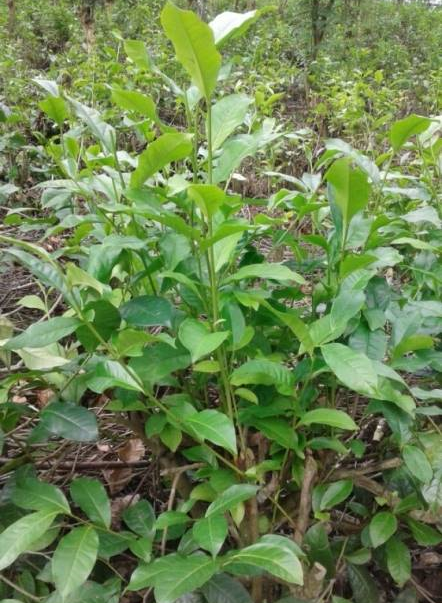
Findings
The findings of this case study can be related with the NDCs Plan of Sri Lanka. Emphasizing the agriculture sector components, Table
Conclusion
Implementation of NDCs is a massive undertaking, as Sri Lanka has to use its own public funds as well as international donations and other aid funds. However, implementation of NDCs is at the grassroots level and therefore, identification of real grassroots level practice is very important for both sides. This study shows the matching elements of grassroots level practices and policy level mechanism to enhance Integrated Pest Management (IPM) practices as enable to address the issues of pest damages, environmental impacts improvement and health. Accordingly, this case study, based on farmers’ indigenous knowledge of adaptation and mitigation techniques on a small scale basis, makes a contribution by identifying these native techniques. This current practice will prove and helpful in the integration of the NDCs program in Sri Lanka and fulfil the UNFCCC’s objectives in the global scene.
Acknowledgments
Authors would like to acknowledge this publication as an outcome of the MoU between Universiti Sains Malaysia (USM) and University of Ruhuna (UoR).
References
- Haque, A. E., Lohano, H. D., Mukhopadhyay, P., Nepal, M., Shafeeqa, F., & Vidanage, S. P. (2019). NDC pledges of South Asia: are the stakeholders onboard? Climatic Change, 155(2), 237-244. https://doi.org/10.1007/s10584-019-02417-6
- Hewawasam, V., & Matsui, K. (2019). Historical development of climate change policies and the Climate Change Secretariat in Sri Lanka. Environmental Science & Policy, 101, 255-261
- Jayasinghe, S. L., & Kumar, L. (2019). Modeling the climate suitability of tea [Camellia sinensis (L.) O. Kuntze] in Sri Lanka in response to current and future climate change scenarios. Agricultural and Forest Meteorology, 272, 102-117
- Ministry of Forestry and Environment (2000). Initial National Communication from United Nations Framework of Convention on Climate Change Sri Lanka.
- Ministry of Environment of Sri Lanka (2010). Sri Lanka's Second National Communication on Climate Change.
- Ministry of Mahaweli Development and Environment (2015). National Adaptation Plan for Climate Change Impacts in Sri Lanka 2016-2015.
- Ministry of Mahavali Development and Environment (MMDE) (2016). Annual Report of Environment.
- Ministry of Mahaweli Development and Environmental (2017). Readiness Plan for Implementation of Intended Nationally Determined Contributions (INDCs) 2017-2019. Ministry of Mahaweli Development and Environmental-Sri Lanka.
- Pauw, W. P., Klein, R. J., Mbeva, K., Dzebo, A., Cassanmagnago, D., & Rudloff, A. (2018). Beyond headline mitigation numbers: we need more transparent and comparable NDCs to achieve the Paris Agreement on climate change. Climatic Change, 147(1-2), 23-29. https://doi.org/10.1007/s10584-017-2122-x
- Silva, De. G., & Abesinghe, S. (2011). Global warming and climatic change: A case study on dairy farmers’ awareness and adoption measures in Anuradhapura district of Sri Lanka. Proceedings of International Forestry and Environment Symposium.
- The Asian Foundation (2012). Report on Climate Change Perception Survey December 2012, Dhaka, Bangladesh
- Wijeratne, M., Anandacoomaraswamy, A., Amarathunga, M., Ratnasiri, J., Basnayake, B., & Kalra, N. (2007). Assessment of impact of climate change on productivity of tea plantations in Sri Lanka. Journal of the National Science Foundation of Sri Lanka, 35(2), 119-126.
- World Health Organization (WHO) (2015). Review of Climate Change and Health Activities in Sri Lanka.
Copyright information

This work is licensed under a Creative Commons Attribution-NonCommercial-NoDerivatives 4.0 International License.
About this article
Publication Date
12 October 2020
Article Doi
eBook ISBN
978-1-80296-088-4
Publisher
European Publisher
Volume
89
Print ISBN (optional)
-
Edition Number
1st Edition
Pages
1-796
Subjects
Business, innovation, sustainability, environment, green business, environmental issues, urban planning, municipal planning, disasters, social impact of disasters
Cite this article as:
Hemakumara, G. P. T. S., Harshani, N. K. G., & Hewage, P. (2020). Overview of Current Climate Change Mitigation and Adaptation Practice in Sri Lanka: A Case Study. In N. Samat, J. Sulong, M. Pourya Asl, P. Keikhosrokiani, Y. Azam, & S. T. K. Leng (Eds.), Innovation and Transformation in Humanities for a Sustainable Tomorrow, vol 89. European Proceedings of Social and Behavioural Sciences (pp. 422-431). European Publisher. https://doi.org/10.15405/epsbs.2020.10.02.38

